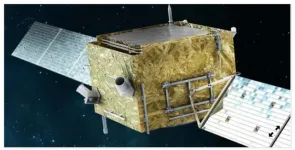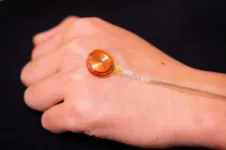(Press-News.org) During the era of commercial whaling, fin whales were hunted so intensively that only a small percentage of the population in the Southern Hemisphere survived, and even today, marine biologists know little about the life of the world's second-largest whale. That makes the findings of researchers from the Alfred Wegener Institute, Helmholtz Centre for Polar and Marine Research (AWI) and the Johann Heinrich von Thünen Institute for Sea Fisheries, which show that a large number of the baleen whales regularly frequent the krill-rich waters surrounding Elephant Island, all the more welcome. Evidence for this is provided by underwater sound recordings from the region, where in the peak month of May, so many fin whale vocalizations can be heard that the individual calls merge into a veritable chorous of sound, as the research team now reports in the journal Royal Society Open Science. In view of this, the marine biologists call for protective measures for this important habitat so as not to jeopardise the apparent recovery of the fin whale population.
Fin whales are still rare and, according to the textbooks, normally appear in groups of three to a maximum of seven. As such, AWI marine biologist Elke Burkhardt was all the more surprised when in the late southern summer of 2012, while on an expedition in the Scotia Sea on board the German research icebreaker Polarstern, she counted more than 100 hundred fin whales in the waters north of Elephant Island. Was this a chance find, or did it mean that such large numbers of the world's second-largest baleen whale gathered here regularly? And if so, why?
To answer this question, in January 2013 Burkhardt and her team installed a mooring with two underwater acoustic recorders and a device used to determine the food supply in the coastal area northwest of the island. Over a period of three years, from January 2013 to February 2016, the instruments recorded the soundscape of the underwater world and gathered data on the food supply in the upper water column. By doing so, they helped identify one of the southern fin whale's most important habitats.
"Our observations from Polarstern were no fluke. As our results show, from December to August the whales regularly inhabit the waters surrounding Elephant Island. Here they not only hunt Antarctic krill, but also search for mates. Our recorders registered the most fin whale calls precisely in the season when the breeding period begins for the Southern Hemisphere population," Burkhardt reports.
Fin whales can be identified by the low-frequency calls that are typical of the species: "Humans would probably only perceive them as vibrations in the pit of the stomach, since their central frequency is roughly 20 hertz, making them exceptionally deep," explains Burkhardt. Male Fin whales that are ready to mate and want to attract females emit these bass sounds in rapid, regular intervals. "Their courtship behaviour may also explain why, in the month of May, our instruments recorded so many of these calls that they merged and were barely discernable as individual sounds," says the AWI marine biologist.
New arguments in favour of a marine protected area around Elephant Island
She was thrilled to discover the numerous fin whales around Elephant Island: "If this aggregation really is an indication that the fin whale population is growing, it would represent a notable achievement for the international whaling moratorium, which entered into effect 35 years ago," she explains.
At the same time, the new findings are a cause for concern. "On the one hand, Antarctic krill are extensively fished in the Scotia Sea; on the other, the region, which is extremely important for fin whales, is frequently visited by cruise ships. That makes it all the more important to comprehensively protect the waters around Elephant Island, and to regulate both krill fishing and tourism in order to avoid harming the fin whale stocks," Burkhardt says. Accordingly, the soundscape should be recorded at regular intervals to document any changes in the population.
Where do the fin whales from Elephant Island spend the winter?
While analysing the underwater recordings, the research team discovered another interesting detail: the 20-Hz pulse also contains an accompanying sound with a frequency of 86 Hz. This in turn resembles the fin whale calls that Chilean marine biologists had previously recorded off the coast of central Chile - particularly at the time of year when the instruments at Elephant Island rarely recorded the sounds of the baleen whales. Was it possible that the same whale population produced the sounds in both regions, and that it moved back and forth between the South Shetland Islands, which Elephant Island belongs to, and the Pacific coast of Chile?
"It is believed that fin whales produce population-specific accompanying higher frequency sounds, which can be used to distinguish between different populations. If this is the case, we can likely conclude that those fin whales that inhabit the waters surrounding Elephant Island in the southern summer may give birth to their calves in the warmer waters off Chile's Pacific coast later in the year, and that these whales regularly travel between the two regions," says Burkhardt.
However, to verify this, further studies are required. To this end, the Bremerhaven-based research team has installed additional underwater recording devices, which will tentatively be retrieved in 2022, in the vicinity of the island. The marine biologists are currently analysing their underwater recordings from the period since 2016. And the first excerpts are promising: in the summers after 2016, Elephant Island continued to be a favourite gathering place for fin whales.
INFORMATION:
Original Publication: Elke Burkhardt, Ilse Van Opzeeland, Boris Cisewski, Ramona Mattmüller, Marlene Meister, Elena Schall, Stefanie Spiesecke, Karolin Thomisch, Sarah Zwicker and Olaf Boebel (2021): Seasonal and diel cycles of fin whale acoustic occurrence near Elephant Island, Antarctica. R. Soc. Open Sci. 8: 201142. https://doi.org/10.1098/rsos.201142
An international archaeological study, led by researchers from the Culture and Socio-Ecological Dynamics (CaSEs) research group at Pompeu Fabra University, has advanced in the understanding and preservation of archaeological sites and in improving their analysis and surveying, thanks to the application of pXRF (portable X-ray fluorescence analysis) to anthropogenic sediments in Africa. It is a rapid, inexpensive, non-invasive procedure, which enables generating an additional archaeological record from the anthropogenic deposit by analysing chemical elements, combined with geostatistics.
It is a rapid, inexpensive, non-invasive procedure, ...
The work was conducted under the auspices of the Russian Foundation for Basic Research and organizations-participants of the BRICS framework program in science, technology and innovation; the grant title is "Nanosized peptide-based biomaterials for photodynamic diagnostics of tumors".
Project lead, Chief Research Associate of KFU's Bionanotechnology Lab Rawil Fakhrullin commented on the results, "The development of materials for theranostics (simultaneous early diagnosis and therapy of diseases) is one of the most urgent tasks in modern chemistry and biomedicine. A feature of such materials is the combination of at least two functions: sensory and therapeutic. ...
A research group led by Takashi Saito, of the Ehime University Graduate School of Medicine, developed a 2-photon excitation light-sheet fluorescence microscope which (1) lowers phototoxicity, (2) extends the field of view, and (3) heightens spatial resolution. This microscope, when used for the observation of medaka fish, made it possible to observe the whole body of the embryo (an extended field of view) at a cellular level resolution (high spatial resolution) without affecting the growth of the fish (low phototoxicity) over a three-day span of embryonic development. ...
The research team of the Department of Organic Chemistry of Samara Polytech under the leadership of Doctor of Chemical Sciences, Head of the Department Yuri Klimochkin and Doctor of Chemical Sciences, Professor Alexander Reznikov in cooperation with the crystallographic research group of Lomonosov Moscow State University (supervisor - candidate of chemical sciences, senior researcher Victor Rybakov) completed a study to obtain non-racemic 4,5-dihydrofurans based on Michael addition and study their chemical properties. The announcement of a scientific article with the results of the latest research is posted on the cover of the authoritative journal Tetrahedron.
"Studying the method of obtaining ...
CHAPEL HILL, NC - A new study published in Nature Communications demonstrates that a consortium of bacteria designed to complement missing or underrepresented functions in the imbalanced microbiome of inflammatory bowel disease (IBD) patients, prevented and treated chronic immune-mediated colitis in humanized mouse models. The study's senior author, Balfour Sartor, MD, Midget Distinguished Professor of Medicine, Microbiology and Immunology, Co-Director of the UNC Multidisciplinary IBD Center, said the results are encouraging for future use treating Crohn's disease and ulcerative colitis patients.
"The idea with this treatment is to restore the normal ...
Dark Matter Particle Explorer (DAMPE) Collaboration directly observed a spectral softening of helium nuclei at about 34TeV for the first time. This work was based on measurements data of the helium spectrum with kinetic energies from 70 GeV to 80 TeV (17.5 GeV/n to 20 TeV/n for per nucleon) recorded by the DAMPE.
The relevant results were published in Physical Review Letters.
Galactic cosmic rays (GCRs) offers important ways to deeply understand the astrophysical particle origin and accelerators and the interstellar medium of the Galaxy. Helium nuclei, the second most abundant nuclear element of cosmic rays, is a distinguishing feature of space.
As for GCRs, the energy spectrum is supposed to follow a negative power law distribution when energies are below the "knee" (at ...
By putting a piece of soft, strain-sensing sheet on the skin may be able to detect skin disorders non-invasively and in real-time very soon. A research team co-led by a scientist from City University of Hong Kong (CityU) has designed a simple electromechanical device that can be used for deep tissue pathology diagnosis, such as psoriasis, in an automated and non-invasive fashion. The findings will lay a foundation for future applications in the clinical evaluation of skin cancers and or dermatology diseases.
The research is co-led by Dr Yu Xinge, Assistant Professor from CityU's Department of Biomedical Engineering, and scientists from and Northwestern University in the US. Their findings have been published in the science journal Nature Biomedical Engineering, titled "Miniaturized ...
New Haven, Conn. -- The ancient burrowers of the seafloor have been getting a bum rap for years.
These prehistoric dirt churners -- a wide assortment of worms, trilobites, and other animals that lived in Earth's oceans hundreds of millions of years ago -- are thought to have played a key role in creating the conditions needed for marine life to flourish. Their activities altered the chemical makeup of the sea itself and the amount of oxygen in the oceans, in a process called bioturbation.
But did that bioturbation help or hinder the expansion of complex animal life? A new Yale study, published in the journal Earth and Planetary Science Letters, found that ...
New Haven, Conn. -- When San Francisco voters overwhelmingly approved a ballot measure banning the sale of flavored tobacco products in 2018, public health advocates celebrated. After all, tobacco use poses a significant threat to public health and health equity, and flavors are particularly attractive to youth.
But according to a new study from the Yale School of Public Health (YSPH), that law may have had the opposite effect. Analyses found that, after the ban's implementation, high school students' odds of smoking conventional cigarettes doubled in San Francisco's school district relative to trends in districts without the ban, even when adjusting for individual demographics and other ...
This new 3D effect can be the foundation for topological quantum phenomena, which are believed to be particularly robust and therefore promising candidates for extremely powerful quantum technologies. These results have just been published in the scientific journal Nature Communications.
Dr. Tobias Meng and Dr. Johannes Gooth are early career researchers in the Würzburg-Dresdner Cluster of Excellence ct.qmat that researches topological quantum materials since 2019. They could hardly believe the findings of a recent publication in "Nature" claiming that electrons in the topological metal zirconium pentatelluride (ZrTe5) move only in two-dimensional ...





